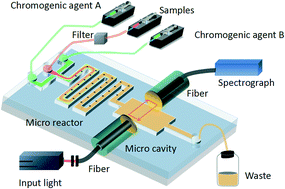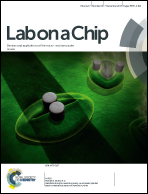Optofluidic marine phosphate detection with enhanced absorption using a Fabry–Pérot resonator
Abstract
Real-time detection of phosphate has significant meaning in marine environmental monitoring and forecasting the occurrence of harmful algal blooms. Conventional monitoring instruments are dependent on artificial sampling and laboratory analysis. They have various shortcomings for real-time applications because of the large equipment size and high production cost, with low target selectivity and the requirement of time-consuming procedures to obtain the detection results. We propose an optofluidic miniaturized analysis chip combined with micro-resonators to achieve real-time phosphate detection. The quantitative water-soluble components are controlled by the flow rate of the phosphate solution, chromogenic agent A (ascorbic acid solution) and chromogenic agent B (12% ammonium molybdate solution, 80% concentrated sulfuric acid and 8% antimony potassium tartrate solution with a volume ratio of 80 : 18 : 2). Subsequently, an on-chip Fabry–Pérot microcavity is formed with a pair of aligned coated fiber facets. With the help of optical feedback, the absorption of phosphate can be enhanced, which can avoid the disadvantages of the macroscale absorption cells in traditional instruments. It can also overcome the difficulties of traditional instruments in terms of size, parallel processing of numerous samples and real-time monitoring, etc. The absorption cell length is shortened to 300 μm with a detection limit of 0.1 μmol L−1. The time required for detection is shortened from 20 min to 6 seconds. Predictably, microsensors based on optofluidic technology will have potential in the field of marine environmental monitoring.



 Please wait while we load your content...
Please wait while we load your content...